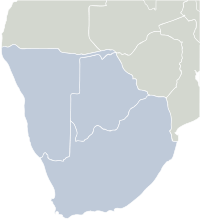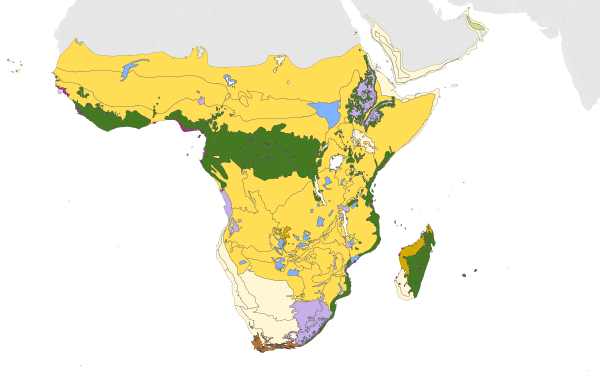Afrotropical realm
The Afrotropical realm is one of the Earth's eight biogeographic realms. It includes Africa south of the Sahara Desert, the majority of the Arabian Peninsula, the island of Madagascar, southern Iran and extreme southwestern Pakistan, and the islands of the western Indian Ocean. It was formerly known as the Ethiopian Zone or Ethiopian Region.

Major ecological regions
Most of the Afrotropic, with the exception of Africa's southern tip, has a tropical climate. A broad belt of deserts, including the Atlantic and Sahara deserts of northern Africa and the Arabian Desert of the Arabian Peninsula, separate the Afrotropic from the Palearctic realm, which includes northern Africa and temperate Eurasia.
Sahel and Sudan
South of the Sahara, two belts of tropical grassland and savanna run east and west across the continent, from the Atlantic Ocean to the Ethiopian Highlands. Immediately south of the Sahara lies the Sahel belt, a transitional zone of semi-arid short grassland and acacia savanna. Rainfall increases further south in the Sudanian Savanna, also known simply as the Sudan, a belt of taller grasslands and savannas. The Sudanian Savanna is home to two great flooded grasslands, the Sudd wetland in South Sudan, and the Niger Inland Delta in Mali. The forest-savanna mosaic is a transitional zone between the grasslands and the belt of tropical moist broadleaf forests near the equator.
Southern Arabian woodlands
South Arabia, which includes Yemen and parts of western Oman and southwestern Saudi Arabia, has few permanent forests. Some of the notable are Jabal Bura', Jabal Raymah, and Jabal Badaj in the Yemeni highland escarpment, and the seasonal forests in eastern Yemen and the Dhofar region of Oman. Other woodlands scatter the land and are very small and are predominantly juniper or acacia forests.
Forest zone
The forest zone, a belt of lowland tropical moist broadleaf forests, runs across most of equatorial Africa's intertropical convergence zone. The Upper Guinean forests of West Africa extend along the coast from Guinea to Togo. The Dahomey Gap, a zone of forest-savanna mosaic that reaches to the coast, separates the Upper Guinean forests from the Lower Guinean forests, which extend along the Gulf of Guinea from eastern Benin through Cameroon and Gabon to the western Democratic Republic of the Congo. The largest tropical forest zone in Africa is the Congolian forests of the Congo Basin in Central Africa.
A belt of tropical moist broadleaf forest also runs along the Indian Ocean coast, from southern Somalia to South Africa.
East African grasslands and savannas
- Acacia-Commiphora grasslands
- Serengeti
Eastern Africa's highlands
Afromontane region, from the Ethiopian Highlands to the Drakensberg Mountains of South Africa, including the East African Rift. Distinctive flora, including Podocarpus and Afrocarpus, as well as giant Lobelias and Senecios.
- Ethiopian Highlands
- Albertine rift montane forests
- East African montane forests and Eastern Arc forests
Zambezian Region
The Zambezian region includes woodlands, savannas, grasslands, and thickets. Characteristic plant communities include Miombo woodlands, drier mopane and Baikiaea woodlands, and higher-elevation Bushveld. It extends from east to west in a broad belt across the continent, south of the rainforests of the Guineo-Congolian region, and north of the deserts of southeastern Africa, the Highveld grasslands of South Africa, and the subtropical Maputaland forests on the southeast.[1]
Deserts of southern Africa

- Namib Desert
- Kalahari Desert
- Karoo
- Tankwa Karoo
- Richtersveld
Cape floristic region
The Cape floristic region, at Africa's southern tip, is a Mediterranean climate region that is home to a significant number of endemic taxa, as well as to plant families like the proteas (Proteaceae) that are also found in the Australasian realm.
Madagascar and the Indian Ocean islands
Madagascar and neighboring islands form a distinctive sub-region of the realm, with numerous endemic taxa like the lemurs. Madagascar and the Granitic Seychelles are old pieces of the ancient supercontinent of Gondwana, and broke away from Africa millions of years ago. Other Indian Ocean islands, like the Comoros and Mascarene Islands, are volcanic islands that formed more recently. Madagascar contains a variety of plant habitats, from rainforests to mountains and deserts, as its biodiversity and ratio of endemism is extremely high.
Endemic plants and animals
Plants
The Afrotropical realm is home to a number of endemic plant families. Madagascar and the Indian Ocean Islands are home to ten endemic families of flowering plants; eight are endemic to Madagascar (Asteropeiaceae, Didymelaceae, Didiereaceae, Kaliphoraceae, Melanophyllaceae, Physenaceae, Sarcolaenaceae, and Sphaerosepalaceae), one to Seychelles (Mesdusagynaceae) and one to the Mascarene Islands (Psiloxylaceae). Twelve plant families are endemic or nearly endemic to South Africa (including Curtisiaceae, Heteropyxidaceae, Penaeaceae, Psiloxylaceae and Rhynchocalycaceae) of which five are endemic to the Cape floristic province (including Grubbiaceae). Other endemic Afrotropic families include Barbeyaceae, Montiniaceae, Myrothamnaceae and Oliniaceae.
Animals
The East African Great Lakes (Victoria, Malawi, and Tanganyika) are the center of biodiversity of many freshwater fishes, especially cichlids (they harbor more than two-thirds of the estimated 2,000 species in the family).[2] The West African coastal rivers region covers only a fraction of West Africa, but harbours 322 of West African's fish species, with 247 restricted to this area and 129 restricted even to smaller ranges. The central rivers fauna comprises 194 fish species, with 119 endemics and only 33 restricted to small areas.[3]
The Afrotropic has various endemic bird families, including ostriches (Struthionidae), sunbirds, the secretary bird (Sagittariidae), guineafowl (Numididae), and mousebirds (Coliidae). Also, several families of passerines are limited to the Afrotropics; These include rock-jumpers (Chaetopidae) and rockfowl (Picathartidae).
Africa has three endemic orders of mammals, the Tubulidentata (aardvarks), Afrosoricida (tenrecs and golden moles), and Macroscelidea (elephant shrews). The East-African plains are well known for their diversity of large mammals.
Four species of great apes (Hominidae) are endemic to Africa: both species of gorilla (western gorilla, Gorilla gorilla, and eastern gorilla, Gorilla beringei) and both species of chimpanzee (common chimpanzee, Pan troglodytes, and bonobo, Pan paniscus). Humans and their ancestors originated in Africa.
Afrotropical terrestrial ecoregions

| Cape Verde Islands dry forests | Cape Verde |
| Madagascar dry deciduous forests | Madagascar |
| Zambezian Cryptosepalum dry forests | Zambia, Angola |
| Al Hajar Al Gharbi montane woodlands | Oman |
| Amsterdam and Saint-Paul Islands temperate grasslands | Amsterdam Island, Saint-Paul Island |
| Tristan da Cunha-Gough Islands shrub and grasslands | Tristan da Cunha, Gough Island |
| East African halophytics | Kenya, Tanzania |
| Etosha Pan halophytics | Namibia |
| Inner Niger Delta flooded savanna | Mali |
| Lake Chad flooded savanna | Cameroon, Chad, Niger, Nigeria |
| Saharan flooded grasslands | South Sudan |
| Zambezian coastal flooded savanna | Mozambique |
| Zambezian flooded grasslands | Angola, Botswana, Democratic Republic of the Congo, Malawi, Mozambique, Tanzania, Zambia |
| Zambezian halophytics | Botswana |
| Angolan montane forest-grassland mosaic | Angola |
| Angolan Scarp savanna and woodlands | Angola |
| Drakensberg alti-montane grasslands and woodlands | Lesotho, South Africa |
| Drakensberg montane grasslands, woodlands and forests | Lesotho, South Africa, Eswatini (Swaziland) |
| East African montane moorlands | Kenya, Sudan, Tanzania, Uganda |
| Eastern Zimbabwe montane forest-grassland mosaic | Mozambique, Zimbabwe |
| Ethiopian montane grasslands and woodlands | Ethiopia, Sudan |
| Ethiopian montane moorlands | Ethiopia, Sudan |
| Highveld grasslands | Lesotho, South Africa |
| Jos Plateau forest-grassland mosaic | Nigeria |
| Madagascar ericoid thickets | Madagascar |
| Maputaland-Pondoland bushland and thickets | Mozambique, South Africa, Eswatini (Swaziland) |
| Ruwenzori-Virunga montane moorlands | Democratic Republic of the Congo, Rwanda, Uganda |
| South Malawi montane forest-grassland mosaic | Malawi, Mozambique |
| Southern Rift montane forest-grassland mosaic | Malawi, Tanzania |
| Albany thickets | South Africa |
| Lowland fynbos and renosterveld | South Africa |
| Montane fynbos and renosterveld | South Africa |
See also
References
- Linder, H. Peter, Helen M. de Klerk, Julia Born et al. (2012). "The partitioning of Africa: statistically defined biogeographical regions in sub‐Saharan Africa". Journal of Biogeography, Volume 39, Issue 7 May 2012.
- I.P.Farias et al., Total Evidence: Molecules, Morphology, and the Phylogenetics of Cichlid Fishes, Journal of Experimental Zoology (Mol Dev Evol) 288:76–92 (2000)
- T.Moritz and K. E. Linsenmair, West African fish diversity – distribution patterns and possible conclusions for conservation strategies (in African Biodiversity: Molecules, Organisms, Ecosystems, Springer, 2001)
- Eric Dinerstein, David Olson, Anup Joshi, Carly Vynne, Neil D. Burgess, Eric Wikramanayake, Nathan Hahn, Suzanne Palminteri, Prashant Hedao, Reed Noss, Matt Hansen, Harvey Locke, Erle C Ellis, Benjamin Jones, Charles Victor Barber, Randy Hayes, Cyril Kormos, Vance Martin, Eileen Crist, Wes Sechrest, Lori Price, Jonathan E. M. Baillie, Don Weeden, Kierán Suckling, Crystal Davis, Nigel Sizer, Rebecca Moore, David Thau, Tanya Birch, Peter Potapov, Svetlana Turubanova, Alexandra Tyukavina, Nadia de Souza, Lilian Pintea, José C. Brito, Othman A. Llewellyn, Anthony G. Miller, Annette Patzelt, Shahina A. Ghazanfar, Jonathan Timberlake, Heinz Klöser, Yara Shennan-Farpón, Roeland Kindt, Jens-Peter Barnekow Lillesø, Paulo van Breugel, Lars Graudal, Maianna Voge, Khalaf F. Al-Shammari, Muhammad Saleem, An Ecoregion-Based Approach to Protecting Half the Terrestrial Realm, BioScience, Volume 67, Issue 6, June 2017, Pages 534–545, .
External links
| Wikimedia Commons has media related to Afrotropic. |
| Wikivoyage has a travel guide for African wildlife. |
Bibliography
- Burgess, N., J.D. Hales, E. Underwood, and E. Dinerstein (2004). Terrestrial Ecoregions of Africa and Madagascar: A Conservation Assessment. Island Press, Washington, D.C., .
- Thieme, M.L., R. Abell, M.L.J. Stiassny, P. Skelton, B. Lehner, G.G. Teugels, E. Dinerstein, A.K. Toham, N. Burgess & D. Olson. 2005. Freshwater ecoregions of Africa and Madagascar: A conservation assessment. Washington DC: WWF, .